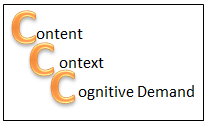One of the topics we are often asked to present at conferences is how to align a material to state standards. Before you begin the hard work of aligning instructional materials, you must ensure that teachers understand the knowledge and skills each Student Expectation requires students to learn.
Each Student Expectation contains three parts, which we call the “Three Cs of the Standard”: the content, context and cognitive demand.
- The Content of the Expectation states what students are required to learn. The content is typically the noun(s) of the Student Expectation.

- The Context of the Expectation is where/when the learning should be taking place.
- In the Common Core State Standards, the context may be articulated in the Expectation itself, or the Cluster or Domain may articulate the context for the Expectation.
- In the Texas Essential Knowledge and Skills (TEKS), the context may be articulated in the Student Expectation or in the Knowledge and Skills Statement.
- In ELA, for example, the context of an Expectation is a particular genre. In social studies, the context for an Expectation is often the time period or type of history (e.g., US history, World history, Texas history, etc.). For science, the context is where the learning should be taking place (e.g., in the laboratory, in field investigations, on the Earth’s surface).
- The Cognitive Demand is what the Expectation requires students to be able to do. The cognitive demand is typically the verb(s) of the Student Expectation.
To determine whether a citation (i.e., a page, unit, lesson) in the material is aligned to a Student Expectation, you have to make sure that the citation addresses all three Cs of the Student Expectation. This may be more difficult than it sounds, because Student Expectations are often both compound and complex sentences. Thus, an Expectation typically contains several nouns and several verbs.
If a single citation does not address all of the nouns and verbs contained in an Expectation, teachers must be aware of the citation’s deficit or else their students may not learn all of the knowledge and skills the Expectation requires. Teachers can adjust their instruction to make up for the material’s deficit or assign multiple citations that align to different portions of the Expectation to ensure that students are exposed the entire Expectation.
If you would like to learn more about standards alignment, consider our two-hour, online professional development course, What Alignment Means, Why It Matters, and How to Do It!
14 thoughts on “The Three Cs of Alignment”
Comments are closed.